Archive for the ‘Chinese Folk Arts’ Category
Symbols of Visual Objects
The art form of Chinese folk art is the visual image of the objects in the 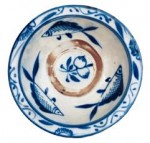 universe, according to the original Chinese philosophy.
universe, according to the original Chinese philosophy.
In primitive society, human was on the weak side in the struggle against natural disasters. Animals with superman capability became supernatural or totem animals in the eyes of humans, for example, polygenetic animals like fish, toad and frog were regarded as female totem symbols from mother’s body of earth and water; animals that were difficult to conquer such as snake, tiger, ox, boar, bear, or with special capability such as flying birds and butterflies; or that ran fast on mountain peaks and precipices like antelope; were male totem symbols, same as the sky and the sun. Over the course of several thousand years, these symbols have been, and still are, used by people of various national background and geographical areas in their respective regional folk art.
In the prairie areas of northern China, the deer totem symbol worshipped by the people in remote antiquity is still a symbol in today’s folk art of the prairie culture; and the pig and the dragon totem from Hongshan culture originated in primitive society in Liaohe basin are still the upper stream 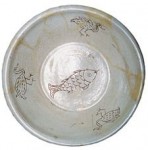 Yangtze River. Regional totem symbols still prevail in today’s folk art.
Yangtze River. Regional totem symbols still prevail in today’s folk art.
In ancient China, people connected natural animals with the sky and earth, and with the theory of yin-yang. Animals in the yang group symbolized the sky and the sun. The unification of “yang” animal from the sky with “yin” animals of earth meant a connection of the sky and earth, or the unity of yinyang. Among Chinese totem animals and legendary animals, the tiger, the ox, the goat, the bird, the bear, the boar, the dog and the cock were of the sky and yang group; the dragon, the snake, the turtle, the fish and the frog were yin group and symbols of earth and water. The dragon, with his head on earth but mating in heaven, was a totem of both worlds (Dragon was originally earth and water animal, but later went to heaven to become the king, and phoenix, an animal in heaven was the queen.) This is rather unique. For example, dragon, being an earth and water totem symbol, later became a cultural symbol of the entire nation in the confluence of multiple national cultures. People integrated the dragon into their own totem animal which turned into the dragon with a boar head in Liaohe basin; or the dragon with a tiger head in the middle-upper stream of the Yellow River; the dragon with a bird head in middle-lower stream of the Yellow River and the Yangtze River; and the dragon with an ox head in middle-upper stream of the Yangtze River. It is also quite common to see “fish with a tiger head” or “fish with a cock head” in Chinese folk art. When two animals are combined into one, it was a cultural symbol that  heaven and earth connect, male and female mate. Other example like “cock holding a fish in the mouth” and “bird holding a fish in the mouth” also implied the connection of heaven and earth, yin and yang. It was a cultural code originated in the communal philosophy in primitive society.
heaven and earth connect, male and female mate. Other example like “cock holding a fish in the mouth” and “bird holding a fish in the mouth” also implied the connection of heaven and earth, yin and yang. It was a cultural code originated in the communal philosophy in primitive society.
Life and Propagation – an All-time Theme
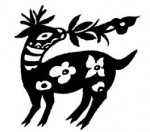 Folk social customs are the carriers of Chinese folk art which has numerous categories and a variety of art forms. However, despite all the categories and forms on the outside, the core lies within the basic cultural consciousness of the people and the original Chinese philosophy.
Folk social customs are the carriers of Chinese folk art which has numerous categories and a variety of art forms. However, despite all the categories and forms on the outside, the core lies within the basic cultural consciousness of the people and the original Chinese philosophy.
To live and to continue life through propagation are the two instinctive desires of humans. From birth, a person’s first instinct is to survive, then to live a long life. However, life and death are immutable laws of nature. Therefore, they turned to seek perpetuity after life, praying for longevity for the living, and perpetuity for the dead. Since the eternity of life could only be achieved through propagation, producing children and grandchildren to pass on life from generation to generation became the ultimate goal. Thus, human perception of propagation was the same as their perception of life itself. Propagation of people and harvesting of crops were deemed as good fortune. In this way, fortune and longevity became the basic cultural consciousness of the people, which was also the main theme of folk art.
Chinese folk art and Chinese philosophy are unified in the belief that yin-yang produces all living things on earth and all living things stay alive through propagation. Originated in Chinese primitive society, this was the philosophical explanation of human’s perception of life and propagation. Chinese ancestor’s philosophical conclusion was to “look at oneself up close and other creatures from afar.” Observing one’s own life in this manner would lead to the understanding of other living things on earth. This conclusion had been the essential cultural understanding of the primitive art to the folk art of the nation.
With the coming of property ownership and intellectual development, thesociety began to be divided into the governing class and the governed. Class society was established. The majority of material and intellectual valuables were disproportionately accumulated in the upper classes where they created a more affluent life style. To get a better life, the concept of profit came into the larger community. The previous cultural concept of “fortune and longevity” expanded into “fortune, longevity, and wealth.” Together they formed the secular culture of folk art. This was especially true in areas that were more culturally and economically developed. Folk art with themes of fortune, longevity, and wealth became widespread. In areas more culturally enclosed with undeveloped communications and economy, the themes were still luck and longevity symbolized by life and propagation. Folk art paper-cut of “Lotus bearing seeds” implied life and propagation in the rural area of northern Shaanxi. On the other hand, in Tianjin where the economy was more developed and transportation had become convenient, New Year woodcut pictures became “Lotus bearing precious seeds” and “Five sons obtaining official promotion.” To become official was to be in the position to obtain wealth.
Transitioning from a natural farming economy to a commodity economy meant that there was a need for profitable commodities. With this change money became important. This evolution in the society brought about a change in the folk art. The “Tree of life” turned into a “Tree that shed coins” or a “Treasure bowl.” The goal in life was no longer to gain basic survival. Life and propagation gradually faded and was replaced by symbols denoting a happy life and good fortune. For example, by combining two items such as a halberd (symbolizing favorable circumstances) and jade (symbolizing fulfillment of ones wishes) auspicious good fortune would replace the original concept of perpetual life. Having many children was symbolized with lotus in a vase. Another example to have every wish granted was expressed by combining two persimmons with jade. The persimmons were symbolic of having everything. The life view changed from simple propagation to living comfortably with extras. Looking at Chinese folk art through different times is like separating cultural layers at an archaeological site. Every shard carries the trace of the historical culture of its time.
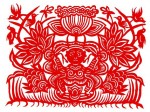 From primitive society to the present day, the view of yin-yang and perpetual life has permeated all aspects of the social life and national culture of Chinese society. Chinese folk art reflects all of the basic philosophical concepts of the society. From my research of Chinese and world archaeological cultures, I have concluded that yin-yang and perpetual life view were the two key factors in opening up the database of Chinese cultural genes. In Western cultures, everything evolves around perpetual life. Whereas yin-yang was regarded as the essence of Chinese cosmic ontology, it was regarded as part of dialectical methodology in the west.
From primitive society to the present day, the view of yin-yang and perpetual life has permeated all aspects of the social life and national culture of Chinese society. Chinese folk art reflects all of the basic philosophical concepts of the society. From my research of Chinese and world archaeological cultures, I have concluded that yin-yang and perpetual life view were the two key factors in opening up the database of Chinese cultural genes. In Western cultures, everything evolves around perpetual life. Whereas yin-yang was regarded as the essence of Chinese cosmic ontology, it was regarded as part of dialectical methodology in the west.
Six Characteristics of Chinese Folk Arts
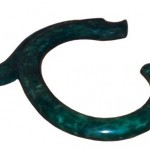 Chinese folk art is a visual art created by ordinary people to meet ordinary social needs. The definition of folk art is relative to the definition of the art of imperial palace, the art of aristocrats, and the art of scholars and of the literati, or professional artists. Firstly, it is a communal art created by millions in the working class, not the work of a few career artists. It is the art of the laborers, not the professionals; it is amateur, not specialized. Secondly, its social function makes it an art of necessity, used in everyday life, production, rites and ceremonies, and beliefs and taboos. It was not intended as a commercial commodity, nor to serve political needs.
Chinese folk art is a visual art created by ordinary people to meet ordinary social needs. The definition of folk art is relative to the definition of the art of imperial palace, the art of aristocrats, and the art of scholars and of the literati, or professional artists. Firstly, it is a communal art created by millions in the working class, not the work of a few career artists. It is the art of the laborers, not the professionals; it is amateur, not specialized. Secondly, its social function makes it an art of necessity, used in everyday life, production, rites and ceremonies, and beliefs and taboos. It was not intended as a commercial commodity, nor to serve political needs.
Looking back on history to the age of primitive society, communal art was created by the Chinese people alongside the creation of tools, shelter and other basic appliances necessary in daily life. The emergence of social classes in society separated the art of the private career artist from folk art, thus forming two major art systems and two cultural heritages in China. The former was the communal art of the people and first came into being in prehistoric time; the latter was the art created by individual career artists and professionals. The parallel growth and mutual influences of these two types of art have been key in driving forward the mainstream of Chinese national art.
In terms of the conservation of national culture, the life of folk art is relatively stable. It represents the ideology of the community; the emotional and psychological characteristics of a nation throughout major periods in history. It is coexistent with national culture; it will not disappear as long as the community exists. Traditional folk art will, however, continue to grow and expand with the passage of time. Cross-cultural exchange and development will continually inject new life into folk art by bringing fresh materials and ideas. Its core, however—its cultural and philosophical origin, its Chinese cultural genes—will remain unchanged.
Chinese folk art has six basic features:
1. It is the art of the people and by the people. The creators are the vast majority of ordinary people as a group.
2. It is the art for the people. It is intended to meet the needs of their daily work, food, clothing, shelter and transportation; as well as their social life of festivals and ceremonies, of beliefs and taboos.
3. Its cultural implication and art forms are reprehensive of the world view of the community, their aesthetics, their motional and psychological characteristics and national spirit. It reflects the system of philosophy, art and 9 color composition in the original Chinese culture. Some popular categories include paper-cutting; floury flower; dress and ornament; embroidery; dye and knitting; exerciser related masks and customs; painting; New Year picture; leather silhouette; puppet; toy; kite; paper folding and lighting art; folk theatrical mask; chess; puzzle; pottery; engraving; residential building; vehicle decoration; household appliance; etc.
4. It is a sector of Chinese parent art. Emerged in primitive society, Chinese folk art inherited the cultural tradition of national literature and art development throughout each and every period in a history of over several thousand years.
5. It is distinctively characterized by individual nationality and geographical region.
6. It is created with commonplace tools and indigent raw materials, characterized by rural natural economy of the region.
In sum, folk art is a unique sector among Chinese national art that enjoys the most popularity and with the richest resource of historical culture. It is directly embedded in people’s every day life and best characterized by the geographical region it represents. It is a long-standing, signature art form of Chinese nation with over 8000 years of history and cultural progress going all the way back to primitive society. From the worship of nature, totem and ancestor; to the urban residence culture of modern capitalist commodity economy; the cultural identity of each h istorical period is recognizable in single piece of art work in some cases. It is truly a living fossil and a museum of national historical culture.